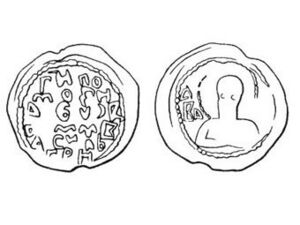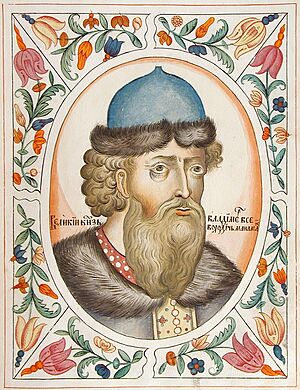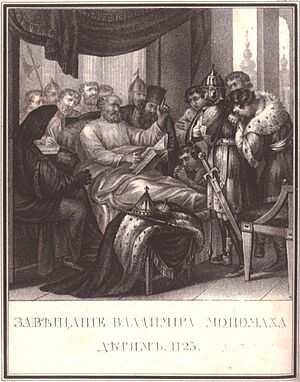Vladimir II Monomakh facts for kids
Quick facts for kids Vladimir II Monomakh |
|||||
|---|---|---|---|---|---|

Seal of Vladimir II Monomakh
|
|||||
| Reign | 1113–1125 | ||||
| Predecessor | Sviatopolk II | ||||
| Successor | Mstislav I of Kiev | ||||
| Prince of Smolensk | |||||
| Reign | 1073–1078 | ||||
| Prince of Chernigov | |||||
| Reign | 1076/8–1094 | ||||
| Predecessor | Vsevolod I of Kiev | ||||
| Successor | Oleg I of Chernigov | ||||
| Prince of Pereyaslav | |||||
| Reign | 1094–1113 | ||||
| Grand Prince of Kiev | |||||
| Reign | 1113–1125 | ||||
| Predecessor | Sviatopolk II of Kiev | ||||
| Successor | Mstislav I of Kiev | ||||
| Born | 26 May 1053 | ||||
| Died | 19 May 1125 (aged 71–72) Kiev |
||||
| Burial | Saint Sophia's Cathedral, Kiev | ||||
| Spouse |
|
||||
| Issue |
|
||||
|
|||||
| Dynasty | Rurik | ||||
| Father | Vsevolod I | ||||
| Mother | Anastasia of Byzantium | ||||
| Religion | Eastern Orthodox | ||||
Vladimir II Monomakh (born May 26, 1053 – died May 19, 1125) was a very important ruler. He was the Grand Prince of Kiev from 1113 to 1125. Many people consider him a saint in the Eastern Orthodox Church. His feast day is celebrated on May 6.
Family and His Special Name
Vladimir Monomakh's father was Vsevolod Yaroslavich. He was a prince from the Rurikids family in Kievan Rus'. In 1046, Vsevolod married a relative of the Byzantine emperor, Constantine IX Monomachos. This marriage helped end a war between Rus' and the Byzantine Empire.
Vladimir was born in 1053. He got his special name, Monomakh, from his mother's family. This was because his mother's family was seen as more important than his father's. His father, Vsevolod, later became the Grand Prince of Kiev from 1078 to 1093.
Vladimir's Time as Ruler
Vladimir Monomakh wrote a famous piece of advice for his children. It's called his Instruction or Testament. In it, he said he fought in 83 battles and made peace with the Polovtsi 19 times. The Polovtsi were a group of nomadic warriors.
At first, Vladimir fought alongside his cousin, Oleg. But later, they became enemies. This was because Oleg made peace with the Polovtsi to take a city from Vladimir. Their rivalry continued for many years, even between their children.
In 1094, Vladimir's main land was the city of Pereiaslav. He also controlled other northern areas like Rostov and Suzdal. He even founded new towns, including Vladimir, which was named after him. This city later became a capital of Russia.
To unite the princes of Rus' against the Polovtsi, Vladimir organized three important meetings. The most famous ones were in Lyubech in 1097 and Dolobsk in 1103. These meetings helped the princes work together.
In 1107, Vladimir defeated a Cuman leader named Boniak. Boniak had led an attack on Kievan Rus'. In 1111, Vladimir and Sviatopolk II won another big victory against the Cumans. This battle happened near the Salnytsia River.
When Sviatopolk II died in 1113, the people of Kiev wanted Vladimir to be their new ruler. They asked him to come to the capital. He arrived in Kiev and ruled there until he died in 1125. He made many changes to help solve problems in the city. His time as ruler is often called a golden age for Kiev.
Vladimir Monomakh was buried in Saint Sophia Cathedral. Many stories are told about him. One legend says that important items, like the Theotokos of Vladimir (a famous icon) and Monomakh's Cap (a crown), were brought to Rus' from Constantinople because of him.
His Marriages and Children
Vladimir Monomakh was married three times. His first wife was likely Gytha of Wessex, the daughter of Harold, King of England. She died in 1107.
Vladimir and his first wife had these children:
- Mstislav I of Kiev (born 1076 – died 1132)
- Izyaslav Vladimirovich (born around 1077 – died 1096)
- Svyatoslav Vladimirovich (born around 1080 – died 1114)
- Yaropolk II of Kiev (born 1082 – died 1139)
- Viacheslav I of Kiev (born 1083 – died 1154)
They also had a daughter:
- Marina Vladimirovna (died 1146). She married Leon Diogenes, who claimed to be a Byzantine prince.
Vladimir's second wife was named Euphemia. She was a noblewoman from the Byzantine Empire.
Vladimir and Euphemia had these children:
- Roman (died 1119)
- Euphemia of Kiev (died 1139). She married Coloman, the King of Hungary.
- Agafia (Agatha). She married Vsevolod Davidovich.
- Yuri (George), also known as Yuri Dolgoruki (died 1157).
- Andrew (born 1102 – died 1141)
Vladimir's third wife is believed to have been a daughter of Aepa Ocenevich, a leader of the Cumans.
See also
 In Spanish: Vladímir II Monómaco para niños
In Spanish: Vladímir II Monómaco para niños
- Council of Liubech



